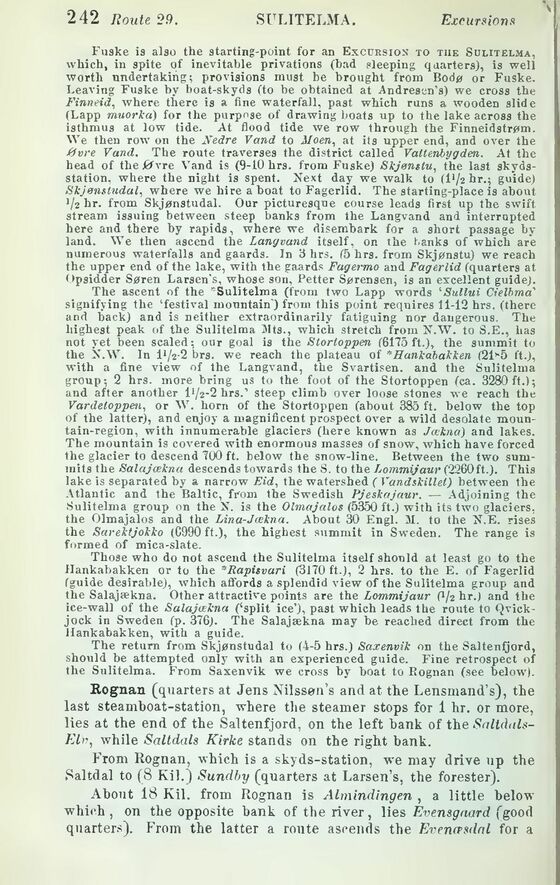
Full resolution (JPEG) - On this page / på denna sida - Norway - Pages ...

<< prev. page << föreg. sida << >> nästa sida >> next page >>
Below is the raw OCR text
from the above scanned image.
Do you see an error? Proofread the page now!
Här nedan syns maskintolkade texten från faksimilbilden ovan.
Ser du något fel? Korrekturläs sidan nu!
This page has never been proofread. / Denna sida har aldrig korrekturlästs.
Fuske is also the starting-point for an Excursion’ to the Sulitelma,
which, in spite of inevitable privations (bad sleeping quarters), is well
worth undertaking; provisions must be brought from Bodø or Fuske.
Leaving Fuske by boat-skyds (to be obtained at Andrescn’s) we cross the
Finneid, where there is a fine waterfall, past which runs a wooden slide
(Lapp muorka) for the purpose of drawing boats up to the lake across the
isthmus at low tide. At flood tide we row through the Finneidstrøm.
We then row on the Nedre Vand to Hoen, at its upper end, and over the
øvre Vand. The route traverses the district called Valtenbygden. At the
head of the Øvre Vand is (9-10 hrs. from Fuske) Skjøntlu, the last
skyds-station, where the night is spent. Xext day we walk to (l>/2 hr.; guide)
Skjønstudal, where we hire a boat to Fagerlid. The starting-place is about
t/2 hr. from Skjønstudal. Our picturesque course leads first up the swift
stream issuing between steep banks from the Langvand and interrupted
here and there by rapids, where we disembark for a short passage
byland. We then ascend the Langvand itself, on the banks of which are
numerous waterfalls and gaards. In 3 hrs. (5 hrs. from Skjønstu) we reach
the upper end of the lake, with the gaards Fagermo and Fagerlid (quarters at
Opsidder Søren Larsen’s, whose son, Petter Sørensen, is an excellent guide).
The ascent of the ‘Sulitelma (from two Lapp words lSullui Cielbma’
signifying the ‘festival mountain’) from this point requires 11-12 hrs. (there
and back) and is neither extraordinarily fatiguing nor dangerous. The
highest peak of the Sulitelma Hits., which stretch from X.W. to S.E., has
not yet been scaled; our goal is the Storloppen (6175ft.), the summit to
the X.W. In H/2-2 brs. we reach the plateau of *Hankabakken (21>-5 ft.),
with a fine view of the Langvand, the Svartisen, and the Sulitelma
group; 2 hrs. more bring us to the foot of the Stortoppen (ca. 3280ft.);
and after another H/2-2 hrs.’ steep climb over loose stones we reach the
Vardeloppeii, or W. horn of the Stortoppen (about 385 ft. below the top
of the latter), and enjoy a magnificent prospect over a wild desolate
mountain-region, with innumerable glaciers (here known as Jcekna) and lakes.
The mountain is covered with enormous masses of snow, which have forced
the glacier to descend 700 ft. below the snow-line. Between the two
summits the Salajcekna descends towards the S. to the Lommijaur (2260ft.). This
lake is separated by a narrow Eid, the watershed ( Vandskillel) between the
Atlantic and the Baltic, from the Swedish Pjeskajaur. — Adjoining the
Sulitelma group on the X. is the Olmajalos (5350 ft.) with its two glaciers,
the Olmajalos and the Lina-Jækna. About 30 Engl. M. to the X.E. rises
the Sarektjokko (C990 ft.), the highest summit in Sweden. The range is
formed of mica-slate.
Those who do not ascend the Sulitelma itself should at least go to the
Hankabakken or to the ~Rapitvari (3170 ft.), 2 hrs. to the E. of Fagerlid
(guide desirable), which affords a splendid view of the Sulitelma group and
the Salajækna. Other attractive points are the Lommijaur 0/2 hr.) and the
ice-wall of the Salajækna (‘split ice’), past which leads the route to
Qvick-jock in Sweden (p. 376). The Salajækna may be reached direct from the
Hankabakken, with a guide.
The return from Skjønstudal to (4-5 hrs.) Saxenvik on the Saltenfjord,
should be attempted only with an experienced guide. Fine retrospect of
the Sulitelma. From Saxenvik we cross by boat to Rognan (see below).
Rognan (quarters at Jens Nilsson’s and at the Lensmand’s), the
last steamboat-station, where the steamer stops for 1 hr. or more,
lies at the end of the Saltenfjord, on the left bank of the
Saltchils-Eln, while Saltdals Kirke stands on the right bank.
From Rognan, which is a skyds-station, we may drive tip the
Saltdal to (8 Kil.) Sundby (quarters at Larsen’s, the forester).
About 18 Kil. from Rognan is Almindingen , a little below
which, on the opposite bank of the river, lies Evensgnard (good
quarters). From the latter a ronte ascends the Evenæsdnl for a
<< prev. page << föreg. sida << >> nästa sida >> next page >>